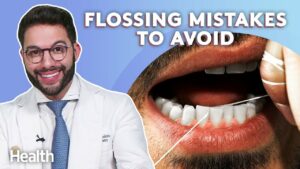In this video, Peter Attia, a medical doctor and investor, discusses the supplements he takes and his rationale behind them. He mentions taking Carlson’s EPA and DHA fish oil for cardiovascular health and vitamin D because he believes the benefits outweigh the risks. He also takes magnesium, methyl folate, and methyl B12 for homocysteine control, and a low dose of B6 to avoid neuropathy risks. He takes a baby aspirin and supplements for mood enhancement and sleep support. Attia emphasizes the importance of personal context and the need for reevaluation based on new data.

Our Summaries are written by our own AI Infrastructure, to save you time on your Health Journey!
Key Insights:
- Taking too much B6 can lead to neuropathy, so it’s important to be cautious with the dosage.
- Peter takes EPA and DHA fish oil from Carlson’s to maintain a specific concentration in his blood.
- He takes 5000 IU of vitamin D daily due to limited and poorly done studies on its benefits.
- Slow-Mag, a slowly and completely absorbed magnesium supplement, is included in his regimen.
- Peter takes methyl folate and methyl B12 to keep homocysteine levels below nine.
- He lowered his B6 intake to 50 milligrams three times a week after realizing he didn’t need as much.
- Peter takes a baby aspirin daily, although evidence for its cardiovascular benefits is weak.
- Ashwagandha, glycine, and magnesium L3 inate are part of his nighttime supplement routine.
- Pendulum glucose control probiotic is a more recent addition for glycemic improvement.
- Peter takes Athletic Greens and a probiotic called Glucose Control by Pendulum.
- His supplement regimen has changed over time, including different brands and additions/removals.
Transcript
I used to take 50 mg of B6 daily. I’ve now lowered that to three times a week. We have seen some people who, when they take too much B6, can actually develop a sort of neuropathy as a result of it. Though, I’ve never experienced any symptoms from it. A little further digging has led me to realize we don’t need nearly as much B6 as I thought we did.
Let’s get into Peter Attia’s list of supplements that he takes. For some reason, I hate talking about this, only because I notice that it tends to show up online and it somehow becomes like, well, if Peter does this, then you should do this or something like that. And you know, there’s no context to it, and therefore, nobody understands the rationale, nobody understands the clinical history, and all of those things.
So, with that caveat, which I don’t think matters because I just, at the end of the day, don’t think people care, I think a lot of people just are sort of searching. But, I take EPA and DHA, so I take fish oil. Again, I’m happy to even state the brands that I take of these things because I don’t have any affiliation with any of these companies, and frankly, I like to give a shout out to companies that I think sell good products.
So, I use Carlson’s EPA and DHA. I can’t remember exactly which one I take. I can never remember their names, but it is the highest EPA version that they have. So, by taking four of these capsules a day, I’m taking roughly two grams of EPA a day and probably a gram and a half of DHA. The reason I take that much is I’m treating to a dose. I’m treating to a red blood cell membrane concentration of EPA in DHA of about 12%. So, that’s a blood test you would do too. So, there you go. You have a biomarker where that I can use to say I’m taking too much, I’m taking too little. Here you go.
I take vitamin D. I’m sorry that I’m blanking on the brand. I can see the bottle, but I’m blanking on the brand. I take 5,000 IU of vitamin D, largely because this is one of those things where I think the risk is insanely low. I think this is really a tricycle. And I’m not sure what I’m picking up. I think it’s more than a penny. I definitely think it’s less than a gold coin. It might be a $5 bill, but I’d pick up a five if I was walking down the street and there was a kid riding a tricycle towards me and I saw a $5 bill, I would pick it up.
I think that most of the studies on vitamin D have been very poorly done, and we do need to do a podcast on this. Maybe this is something we could deep dive on to in an AMA. So, I won’t get into it more now, but having looked very critically at the vitamin D literature, which is insanely underwhelming, I think it is almost assuredly the result of very lousy studies that add no value to our understanding of the problem. So, the dosing has been wrong, the duration has been wrong, the compliance has been wrong, and the targeting has been wrong. So, they’ve just everything has been blown. And so, I would say we truly have no idea.
I take Slow Mag. That is a brand, and I take two or three of those every day. So, that is a slowly and completely absorbed form of magnesium. All in all, I’m trying to get up to about a gram of Mag total magnesium or Elemental magnesium in my system a day, and I get that through again through Slow Mag, through magnesium L3inate, and through magnesium oxide. So, I take all of those things.
I take methyl folate and methyl B12. I use Jarrow as a brand. Again, here we do have biomarkers. You can measure B12 levels. But more than anything, I’m measuring homocysteine levels. That’s why I’m taking methylated versions of those. And basically, I take these to keep homocysteine below nine. That, for me, just means just taking one a day. So, I take the standard dose of that. They do make it in two strengths, and I take the lower of the two. In part because most of us have sort of variance of MTHFR, the variants I have are reasonable at methylation.
This is actually an interesting change. I used to take 50 milligrams of B6 daily. I’ve now lowered that to three times a week. We have seen some people who, when they take too much B6, can actually develop a sort of neuropathy as a result of it. Though, I’ve never experienced any symptoms from it. A little further digging has led me to realize we probably don’t need nearly as much B6 as I thought we did. So, I’ve lowered that to 50 milligrams three times a week, and it helps with the homocysteine. You just have to be careful that you’re not overdoing it.
I take a baby aspirin a day. I think the evidence for the use of baby aspirin in cardioprotection is pretty weak. This is kind of a soft call. I don’t think there’s an evidence-based reason why I should take a baby aspirin. And there’s even some evidence to suggest that once you get significantly older, unless your risk of cardiovascular disease is significantly high, the benefits of it, which are clear, there’s no doubt there are benefits of a baby aspirin, but they’re outweighed by the bleeding risks that are associated with aspirin use, in particular if you fall and hit your head. That becomes a bigger liability. This is one of those things that baby aspirin use falls in and out of favor over time. Given that I am very young, relatively speaking, to these study populations and not really at risk for a bleeding injury, I think of this as picking up a dollar or $2 in front of a tricycle at this point. But again, I’m always happy to re-evaluate the use of this and any supplement for that matter in the presence of new data.
I take Ashwagandha. I take 600 milligrams of Ashwagandha. I recently switched to the Solgar brand. I take two grams of glycine. I use the Thorne brand. I take Magnesium L3in8, which I just mentioned. I use the Magtein brand. By the way, anytime you’re buying Magnesium L3in8, just make sure it has Magtein in it. So, you could buy it from any different company, but they have to have the Magtein proprietary combination because they’re the only people that have the license to make L3in8.
I feel like there’s one other thing I take occasionally for travel. I will take Jarrow’s phosphatidylserine. It comes in 100 mg capsules or gel caps. For some reason, I like the gel caps better. No idea if they’re just more quickly absorbed. I truly have no idea if I’m really going to the trouble of taking it. I’m presumably on a long flight where I’m trying to overcome a significant time zone. So, I usually take about 400 milligrams. That’s a compound that’s been tested readily up to 600 milligrams.
I take Athletic Greens in the morning. Disclosure: I am an investor in that company. I’m also an adviser to that company. So, I take AG1 as a green drink in the morning. And I take a probiotic called Glucose Control by a company called Pendulum. So, I take two of those in the morning with my AG. That’s kind of like the first thing I consume in the morning with those.
Just on the whole, just because you take them, not everyone should take them. And you’re looking at your medical history. What percent of those same supplements and the same doses were you taking a year ago? The question I’m kind of getting at is, yeah, so that way if someone listening to this down the road hears it, they don’t automatically just go do the same thing.
A year ago, I was not taking the Pendulum probiotic. That’s something I’ve only been taking for a couple of months, and I’m doing an experiment there which is looking at average blood glucose. The reason I’m taking this particular probiotic is I believe, having looked at all of these probiotics, I think this is the most rigorously tested and validated probiotic out there. In a small but double-blinded randomized clinical trial, it demonstrated a 6% (meaning 6 absolute percentage point) reduction in hemoglobin A1c in people with type 2 diabetes. That was only in 90 days, which is pretty interesting. It also demonstrated and caused about a 30% reduction in postprandial glucose (area under the curve). So, meaning when you gave people a glucose challenge and then measured and plotted a graph of their glucose response and looked at the area under that curve, the people who had been taking this Pendulum Glucose Control probiotic had a 30% reduction in that. Meaning, they had become more insulin-sensitive. And I’m a couple of weeks away from doing a blood test on myself to see if I’ve had any improvement in glycemic markers in response to that.
I was not taking that a year ago. I was not taking Ashwagandha a year ago. I had taken it a long time earlier but just kind of came back to it. Probably found a slightly more potent version of it. I was taking a different brand of fish oil before. I had used Carlson’s in the past, had switched to Nordic Naturals. Now, I’ve switched back to this. I find it to be just a slightly more robust product. The Nordic Naturals ones, for some reason, every third bottle had a broken capsule in it. And once a capsule breaks in the bottle, it just totally destroys the remaining capsules. It was just happening too frequently. I was kind of aggravated by it. I don’t think I was taking a baby aspirin a year ago. I think, again, that’s something I’ve kind of done on and off over periods of time. And probably the same with vitamin D. It’s possible I wasn’t taking vitamin D a year ago.
So, it’s not only the drugs that have changed, but even the B6 you mentioned, the dosing has also changed.





